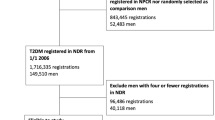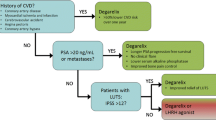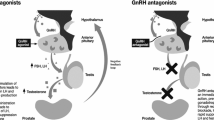Abstract
Gonadotropin-releasing hormone (GnRH) agonists are the mainstay of treatment for recurrent and metastatic prostate cancer. GnRH agonists are also an important part of therapy for many men with localized or locally advanced prostate cancer. Although GnRH agonists improve survival in certain settings, they involve adverse effects including vasomotor flushing, obesity, and osteoporosis. This article describes the evidence that GnRH agonists increase risk for diabetes and cardiovascular disease and reviews the potential mechanisms for treatment-related morbidity.
Similar content being viewed by others
References and Recommended Reading
Sharifi N, Gulley JL, Dahut WL: Androgen deprivation therapy for prostate cancer. JAMA 2005, 294:238–244.
Cooperberg MR, Grossfeld GD, Lubeck DP, Carroll PR: National practice patterns and time trends in androgen ablation for localized prostate cancer. J Natl Cancer Inst 2003, 95:981–989.
Barry MJ, Delorenzo MA, Walker-Corkery ES, et al.: The rising prevalence of androgen deprivation among older American men since the advent of prostate-specific antigen testing: a population-based cohort study. BJU Int 2006, 98:973–978.
Shahinian VB, Kuo YF, Freeman JL, et al.: Increasing use of gonadotropin-releasing hormone agonists for the treatment of localized prostate carcinoma. Cancer 2005, 103:1615–1624.
Keating NL, O’Malley AJ, Smith MR: Diabetes and cardiovascular disease during androgen deprivation for prostate cancer. J Clin Oncol 2006, 24:4448–4456.
Saigal CS, Gore JL, Krupski TL, et al.: Androgen deprivation therapy increases cardiovascular morbidity in men with prostate cancer. Cancer 2007, 110:1493–1500.
Tsai HK, D’Amico AV, Sadetsky N, et al.: Androgen deprivation therapy for localized prostate cancer and the risk of cardiovascular mortality. J Natl Cancer Inst 2007, 99:1516–1524.
D’Amico AV, Denham JW, Crook J, et al.: Influence of androgen suppression therapy for prostate cancer on the frequency and timing of fatal myocardial infarctions. J Clin Oncol 2007, 25:2420–2425.
Efstathiou JA, Bae K, Shipley WU, et al.: Cardiovascular mortality and duration of androgen deprivation therapy for locally advanced prostate cancer: analysis of RTOG 92-02. Eur Urol 2008 (in press).
The Leuprolide Study Group: Leuprolide versus diethylstilbestrol for metastatic prostate cancer. N Engl J Med 1984, 311:1281–1286.
Garnick MB: Leuprolide versus diethylstilbestrol for previously untreated stage D2 prostate cancer. Results of a prospectively randomized trial. Urology 1986, 27:21–28.
Vermeulen A, Goemaere S, Kaufman JM: Testosterone, body composition and aging. J Endocrinol Invest 1999, 22:110–116.
Tayek JA, Heber D, Byerley LO, et al.: Nutritional and metabolic effects of gonadotropin-releasing hormone agonist treatment for prostate cancer. Metabolism 1990, 39:1314–1319.
Smith JC, Bennett S, Evans LM, et al.: The effects of induced hypogonadism on arterial stiffness, body composition, and metabolic parameters in males with prostate cancer. J Clin Endocrinol Metab 2001, 86:4261–4267.
Smith MR, Finkelstein JS, McGovern FJ, et al.: Changes in body composition during androgen deprivation therapy for prostate cancer. J Clin Endocrinol Metab 2002, 87:599–603.
Berruti A, Dogliotti L, Terrone C, et al.: Changes in bone mineral density, lean body mass and fat content as measured by dual energy x-ray absorptiometry in patients with prostate cancer without apparent bone metastases given androgen deprivation therapy. J Urol 2002, 167:2361–2367; discussion 2367.
Smith M: Changes in fat and lean body mass during androgen deprivation therapy for prostate cancer. Urology 2004, 63:742–745.
Lee H, McGovern K, Finkelstein JS, Smith MR: Changes in bone mineral density and body composition during initial and long-term gonadotropin-releasing hormone agonist treatment for prostate carcinoma. Cancer 2005, 104:1633–1637.
Page ST, Herbst KL, Amory JK, et al.: Testosterone administration suppresses adiponectin levels in men. J Androl 2005, 26:85–92.
Smith MR, Lee H, Fallon MA, Nathan DM: Adipocytokines, obesity, and insulin resistance during combined androgen blockade for prostate cancer. Urology 2008 (in press).
Smith MR, Lee H, McGovern FJ, et al.: Metabolic changes during gonadotropin releasing hormone (GnRH) agonist therapy for prostate cancer: differences from the classic metabolic syndrome. Cancer 2008 (in press).
Hotta K, Funahashi T, Arita Y, et al.: Plasma concentrations of a novel, adipose-specific protein, adiponectin, in type 2 diabetic patients. Arterioscler Thromb Vasc Biol 2000, 20:1595–1599.
Kumada M, Kihara S, Sumitsuji S, et al.: Association of hypoadiponectinemia with coronary artery disease in men. Arterioscler Thromb Vasc Biol 2003; 23:85–89.
Rothenbacher D, Brenner H, Marz W, Koenig W: Adiponectin, risk of coronary heart disease and correlations with cardiovascular risk markers. Eur Heart J 2005, 26:1640–1646.
Pischon T, Girman CJ, Hotamisligil GS, et al.: Plasma adiponectin levels and risk of myocardial infarction in men. JAMA 2004, 291:1730–1737.
Lindsay RS, Resnick HE, Zhu J, et al.: Adiponectin and coronary heart disease: the Strong Heart Study. Arterioscler Thromb Vasc Biol 2005, 25:e15–e16.
Lawlor DA, Davey Smith G, Ebrahim S, et al.: Plasma adiponectin levels are associated with insulin resistance, but do not predict future risk of coronary heart disease in women. J Clin Endocrinol Metab 2005, 90:5677–5683.
Laughlin GA, Barrett-Connor E, May S, Langenberg C: Association of adiponectin with coronary heart disease and mortality: the Rancho Bernardo study. Am J Epidemiol 2007, 165:164–174.
Eri LM, Urdal P, Bechensteen AG: Effects of the luteinizing hormone-releasing hormone agonist leuprolide on lipoproteins, fibrinogen and plasminogen activator inhibitor in patients with benign prostatic hyperplasia. J Urol 1995, 154:100–104.
Smith MR, Lee H, Nathan DM: Insulin sensitivity during combined androgen blockade for prostate cancer. J Clin Endocrinol Metab 2006, 91:1305–1308.
American Diabetes Association: Diagnosis and classification of diabetes mellitus. Diabetes Care 2008, 31(Suppl 1):S55–S60.
Despres JP, Lamarche B, Mauriege P, et al.: Hyperinsulinemia as an independent risk factor for ischemic heart disease. N Engl J Med 1996, 334:952–957.
Pyroala M, Miettinen H, Laakso M, Pyorala K: Hyperinsulinemia predicts coronary heart disease risk in healthy middle-aged men: the 22-year follow-up results of the Helsinki Policemen Study. Circulation 1998, 98:398–404.
National Cholesterol Education Program (NCEP) Expert Panel on Detection, Evaluation, and Treatment of High Blood Cholesterol in Adults (Adult Treatment Panel III): Third report of the National Cholesterol Education Program (NCEP) Expert Panel on Detection, Evaluation, and Treatment of High Blood Cholesterol in Adults (Adult Treatment Panel III) final report. Circulation 2002, 106:3143–3421.
Braga-Basaria M, Dobs AS, Muller DC, et al.: Metabolic syndrome in men with prostate cancer undergoing long-term androgen-deprivation therapy. J Clin Oncol 2006, 24:3979–3983.
Kahn R, Buse J, Ferrannini E, Stern M: The metabolic syndrome: time for a critical apprasial: joint statement from the American Diabetes Association and the European Association for the Study of Diabetes. Diabetes Care 2005, 28:2289–2304.
Ferrannini E: Metabolic syndrome: a solution in search of a problem. J Clin Endocrinol Metab 2007, 92:396–398.
Knowler WC, Barrett-Connor E, Fowler SE, et al.: Reduction in the incidence of type 2 diabetes with lifestyle intervention or metformin. N Engl J Med 2002, 346:393–403.
Smith MR: Selective estrogen receptor modulators to prevent treatment-related osteoporosis. Rev Urol 2005, 7(Suppl 3):S30–S35.
Erkkola R, Mattila L, Powles T, et al.: Bone mineral density and lipid changes during 5 years of follow-up in a study of prevention of breast cancer with toremifene in healthy, high-risk pre-and post-menopausal women. Breast Cancer Res Treat 2005, 93:277–287.
Joensuu H, Holli K, Oksanen H, Valavaara R: Serum lipid levels during and after adjuvant toremifene or tamoxifen therapy for breast cancer. Breast Cancer Res Treat 2000, 63:225–234.
Saarto T, Blomqvist C, Ehnholm C, et al.: Antiatherogenic effects of adjuvant antiestrogens: a randomized trial comparing the effects of tamoxifen and toremifene on plasma lipid levels in postmenopausal women with node-positive breast cancer. J Clin Oncol 1996, 14:429–433.
Kusama M, Miyauchi K, Aoyama H, et al.: Effects of toremifene (TOR) and tamoxifen (TAM) on serum lipids in postmenopausal patients with breast cancer. Breast Cancer Res Treat 2004, 88:1–8.
Smith M, Malkowicz SB, Chu F, et al.: Toremifene improves lipid profiles in men receiving androgen deprivation therapy for prostate cancer-interim analysis of a multicenter phase III study. J Clin Oncol 2008 (in press).
Author information
Authors and Affiliations
Corresponding author
Rights and permissions
About this article
Cite this article
Smith, M.R. Androgen deprivation therapy and risk for diabetes and cardiovascular disease in prostate cancer survivors. Curr Urol Rep 9, 197–202 (2008). https://doi.org/10.1007/s11934-008-0035-y
Published:
Issue Date:
DOI: https://doi.org/10.1007/s11934-008-0035-y




